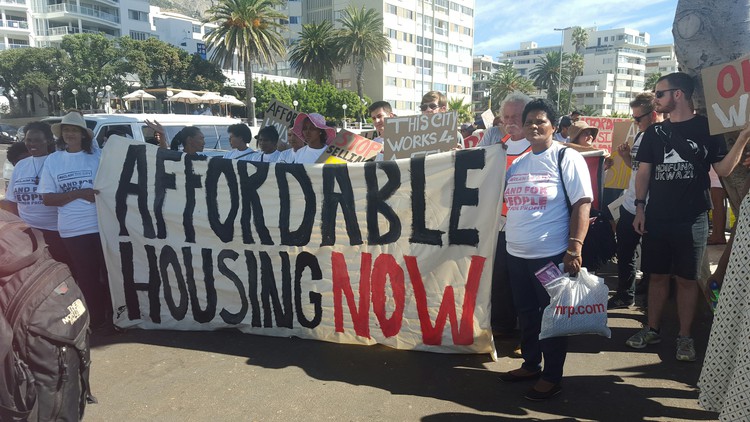
Land occupations across the country have skyrocketed this year. New approaches are needed to solve the housing shortage. Archive photo: Mary-Anne Gontsana
27 June 2018
The housing shortage has come to a head this year with a massive increase in land occupations. For example in Cape Town in 2017 the Anti-Land Invasion Unit removed 15,000 “illegal structures”. Just in the first four months of 2018 this number is already 26,000.
There are questions to be asked to what extent this has been fuelled by the expropriation without compensation debate and the opportunism of the EFF. But there is no doubt that millions of people are fed up. Across the country people, who are angry at what they perceive as unfulfilled promises by politicians and corruption with the RDP housing programme, are occupying both public and private land illegally.
Frequently they are former “backyarders”, people who used to live in shacks on the property of a landlord. In story after story former backyarders tell our reporters they wanted to escape their overcrowded extended family homes or rents that they could not afford.
A common problem is that the land that is occupied is sometimes earmarked for RDP houses for other people, exacerbating the difficulties of finding solutions. Sometimes the occupied land is unsuitable for housing.
Other than unemployment, for which no one is offering coherent or politically feasible solutions, the struggle for housing is the biggest crisis facing poor people in South Africa. In Durban Abahlali baseMjondolo is in a bloody battle with the state. In Cape Town activists from Reclaim the City organised the occupation of two large abandoned provincial properties. In Johannesburg families live in squalid conditions in Wembley Sports Stadium one year after they were evicted.
In the Western Cape alone there are over 500 informal settlements, about 215 of these in Cape Town. The housing backlog is 300,000 in Cape Town according to the provincial Human Settlements Department. The problem is massive, and the provision of houses moves slowly because of a combination of political disagreements and bureaucracy. Premier Helen Zille, for example, recently described the political obstacles the Western Cape government has encountered in the Joe Slovo settlement along the N2.
But what was particularly interesting about Zille’s article is that it makes suggestions that seem not too different from what Ndifuna Ukwazi has been campaigning for. She supported urban densification and welcomed the idea of state-subsidised rentals in multi-storey buildings, so long as they are privately administered.
State subsidised rent is not a new idea, but it is one that is gaining traction. Both Cape Town and Johannesburg have a fair amount of this already. The biggest example of it in Cape Town is Steenvilla in the south peninsula. The City has committed to building about a dozen similar places near the city centre.
State subsidised rental is attractive. It allows low-income households to live in decent accommodation — often much better than RDP houses — close to schools, shops and employment. Properly run rental blocks are more durable than RDP houses. Because they can be built as multi-storey complexes, they can accommodate many more people per square metre, and much more comfortably, than the rows and rows of matchbox houses typical of RDP developments. There is no good reason state-subsidised rentals can’t be done on a large scale. And it can help break down the class and racial barriers of South African cities.
But done badly it will be disastrous. Zille wrote that Cape Town’s “vast housing estates have a very low rent-payment record that hovers around 30%”. They are also often far from the city, decent schools, shopping or jobs, and they are often gang-ridden.
Done well they can be extremely successful. Despite the problems at Steenvilla with a small number of households not paying rent and resisting eviction, the block appears to be well-run and sought after. In contrast to the City’s housing estates it does not look like a slum; it actually looks quite nice from the outside, though it has been through a difficult period.
It is managed by a non-profit organisation called SOHCO. Steenvilla’s rent collection has been at about 80% over the past year during the height of the conflict with the rent defaulters. Countrywide SOHCO’s rent collection on its state subsidised housing is over 90%. Another example of a well-run state-subsidised rental complex is Drommedaris in Bothasig, run by a non-profit company called Communicare.
It’s important to understand that nearly all their tenants are low-income households who would not be able to live where they do without substantial state subsidies. As an alternative to spending money on RDP housing, state subsidised rental is often, albeit not always, better. It is only an option for households that earn enough income to cover the low rents, but it can help alleviate the backlog of RDP houses.
What this suggests is that government should pay the subsidies to reputable companies like SOHCO and Communicare who can then manage the buildings including rent collection, rather than depending on civil servants, who have no incentive to make the subsidised rentals work.
But there is a weakness with the rental model that has no easy solution. What happens when people, either because they have become unemployed or taken some unexpected financial knock, can’t pay the rent? Evictions then follow. Where do the evicted people go?
Currently a bunch of evicted people are living on the pavement outside Steenvilla, which is not good for either them or the residents inside Steenvilla. They will likely end up in a desolate depressing place like Wolwerivier, 25km north of the city centre but which seems a millions miles from anywhere.
So subsidised rental housing, usually run by non-profit organisations, is an idea whose time has come and that can be scaled up. It is a part of the solution to the housing crisis that needs much more investment, but it is not problem free.